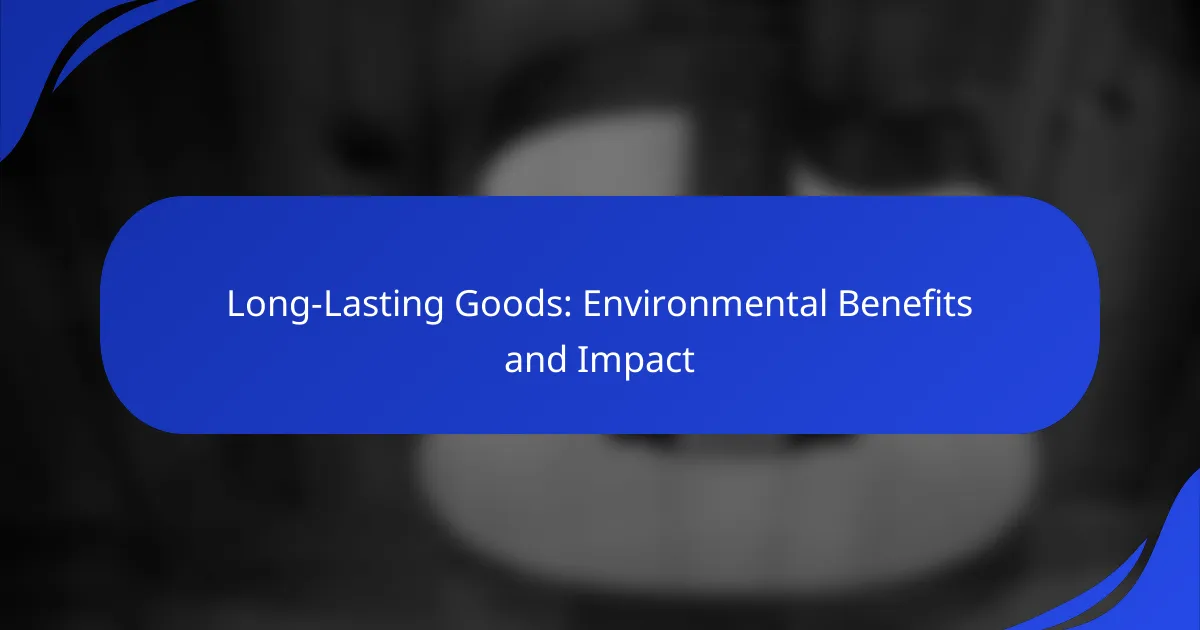Long-lasting goods play a crucial role in promoting environmental sustainability by minimizing waste and conserving valuable resources. By opting for durable products, consumers not only reduce their ecological footprint but also encourage sustainable practices that benefit the planet.

How do long-lasting goods benefit the environment?
Long-lasting goods significantly benefit the environment by reducing waste and conserving resources. By choosing durable products, consumers can minimize their ecological footprint and support sustainable practices.
Reduced waste generation
Long-lasting goods contribute to reduced waste generation by decreasing the frequency of product replacements. When items are designed to last longer, fewer products end up in landfills, which helps mitigate the environmental impact of waste disposal.
For instance, a high-quality appliance may last over a decade, whereas a cheaper alternative might need replacing every few years. This longevity translates to less waste and lower disposal costs for municipalities.
Lower resource consumption
By opting for long-lasting goods, consumers help lower resource consumption, as fewer materials are needed for production over time. Durable products require less frequent manufacturing, which conserves raw materials and energy.
For example, a well-made pair of shoes can last several years, reducing the demand for new materials compared to buying cheaper shoes that wear out quickly. This shift can lead to significant savings in natural resources like leather, rubber, and synthetic fibers.
Decreased carbon footprint
Long-lasting goods help decrease the carbon footprint associated with manufacturing, transportation, and disposal. Each time a product is made, transported, and eventually discarded, it contributes to greenhouse gas emissions.
For instance, a durable electronic device that remains functional for many years avoids the emissions linked to producing multiple replacements. This cumulative effect can lead to a noticeable reduction in overall carbon emissions.
Enhanced recycling potential
Products designed for longevity often have better recycling potential, as they are made from higher-quality materials that can be more easily repurposed. When durable goods reach the end of their life cycle, they can often be recycled rather than discarded.
For example, metal appliances can be recycled into new products, whereas lower-quality items may not be recyclable due to mixed materials. This enhances resource recovery and reduces the need for virgin materials.
Support for sustainable practices
Choosing long-lasting goods supports sustainable practices by encouraging manufacturers to prioritize quality and durability. This consumer preference can drive companies to adopt environmentally friendly production methods and materials.
For instance, brands that focus on creating sustainable products often use recycled materials and ethical labor practices. By supporting these companies, consumers can promote a market that values sustainability and environmental responsibility.

What are the best long-lasting products available?
The best long-lasting products include eco-friendly furniture, durable clothing brands, long-lasting electronics, and reusable kitchenware options. These items are designed to minimize waste and reduce environmental impact while providing reliable performance over time.
Eco-friendly furniture
Eco-friendly furniture is made from sustainable materials, such as reclaimed wood, bamboo, or recycled metals. Brands like IKEA and West Elm offer options that prioritize sustainability without sacrificing style or durability.
When selecting eco-friendly furniture, look for certifications like FSC (Forest Stewardship Council) or Greenguard, which indicate responsible sourcing and low emissions. Investing in quality pieces can lead to long-term savings and less frequent replacements.
Durable clothing brands
Durable clothing brands focus on creating high-quality garments that withstand wear and tear. Companies like Patagonia and Everlane are known for their commitment to sustainability and longevity, often using organic or recycled materials.
To ensure longevity, choose clothing with reinforced seams and natural fibers, which tend to last longer than synthetic options. Regular maintenance, such as proper washing and storage, can further extend the life of your wardrobe.
Long-lasting electronics
Long-lasting electronics are designed to endure years of use, often featuring repairable designs and upgradable components. Brands like Apple and Dell offer products that are built to last, with warranties that reflect their durability.
When purchasing electronics, consider models with strong customer reviews regarding longevity and repairability. Investing in quality chargers and accessories can also help prolong the lifespan of your devices.
Reusable kitchenware options
Reusable kitchenware includes items like stainless steel containers, glass jars, and silicone bags that replace single-use plastics. Brands such as Pyrex and Stasher provide durable alternatives that are both functional and environmentally friendly.
To maximize the benefits of reusable kitchenware, choose products that are dishwasher and microwave safe, ensuring convenience in daily use. Regularly inspect items for wear and replace them as needed to maintain safety and hygiene.

How can consumers choose long-lasting goods?
Consumers can choose long-lasting goods by evaluating product materials, understanding warranty offerings, and researching brand sustainability. These factors help ensure that purchases contribute to environmental benefits and reduce waste over time.
Evaluating product materials
When assessing long-lasting goods, consider the durability and sustainability of the materials used. Look for products made from high-quality, natural, or recycled materials, as they tend to have a longer lifespan and lower environmental impact.
For example, furniture made from solid wood or metal generally lasts longer than items made from particleboard or plastic. Additionally, products with certifications like FSC (Forest Stewardship Council) for wood can indicate responsible sourcing.
Understanding warranty offerings
Warranties can provide insight into a product’s expected lifespan and the manufacturer’s confidence in its durability. A longer warranty period often suggests that the manufacturer believes in the quality of their product.
For instance, electronics with warranties of three years or more may be more reliable than those with one-year coverage. Always read the warranty terms to understand what is covered and for how long.
Researching brand sustainability
Investigating a brand’s sustainability practices can reveal their commitment to producing long-lasting goods. Brands that prioritize eco-friendly practices often invest in quality materials and ethical manufacturing processes.
Check for sustainability certifications, such as ISO 14001, and look for transparency in their supply chain. Brands that publish sustainability reports or engage in environmental initiatives are typically more reliable choices for long-lasting products.

What are the economic impacts of long-lasting goods?
Long-lasting goods have significant economic impacts by reducing overall consumer spending and fostering sustainable practices. These products often lead to fewer replacements and repairs, which can enhance financial stability for both consumers and businesses.
Cost savings over time
Investing in long-lasting goods typically results in cost savings over time. While the initial purchase price may be higher, the durability of these items means they do not need to be replaced as frequently, leading to lower overall expenses. For example, a high-quality appliance may last twice as long as a cheaper alternative, saving hundreds of dollars in the long run.
Additionally, long-lasting goods often come with warranties that cover repairs, further reducing costs associated with maintenance. Consumers should consider the total cost of ownership rather than just the upfront price when making purchases.
Impact on local economies
Long-lasting goods can positively influence local economies by encouraging sustainable manufacturing practices. When consumers prioritize durable products, local businesses that focus on quality over quantity can thrive. This shift can lead to a more resilient economy that is less dependent on constant consumption.
Moreover, as demand for long-lasting products increases, local manufacturers may invest in better production techniques and materials, enhancing their competitiveness. This can create a ripple effect, benefiting suppliers and service providers in the community.
Job creation in sustainable industries
The shift towards long-lasting goods can stimulate job creation in sustainable industries. As companies adapt to meet consumer demand for durable products, they often require skilled labor for design, manufacturing, and maintenance. This can lead to new job opportunities in sectors focused on sustainability.
For instance, the growth of eco-friendly product lines often necessitates hiring workers trained in sustainable practices and technologies. Communities that embrace this shift can see a boost in employment rates, contributing to overall economic health.

How do long-lasting goods compare to disposable alternatives?
Long-lasting goods generally offer significant advantages over disposable alternatives, particularly in terms of environmental impact. These durable products reduce waste, lower resource consumption, and often provide better value over time.
Environmental impact of long-lasting goods
Long-lasting goods contribute to environmental sustainability by minimizing waste and reducing the demand for new materials. When products are designed to last, they require fewer replacements, which in turn decreases the overall consumption of resources such as water, energy, and raw materials.
For instance, a high-quality pair of shoes may last several years, whereas cheaper, disposable options might need to be replaced multiple times within the same period. This not only saves money but also lessens the burden on landfills and lowers carbon emissions associated with manufacturing and transportation.
Cost-effectiveness over time
Investing in long-lasting goods can be more cost-effective than frequently purchasing disposable items. While the initial price of durable products may be higher, their longevity often translates to lower overall costs in the long run.
For example, a durable kitchen appliance may cost more upfront but can last a decade or more, while a cheaper model might need replacement every few years. Consumers should consider the total cost of ownership, including maintenance and replacement, when evaluating their options.
Consumer behavior and choices
Consumer choices play a crucial role in promoting long-lasting goods. By prioritizing quality over price, individuals can drive demand for sustainable products. This shift in behavior encourages manufacturers to focus on durability and eco-friendly practices.
To make informed decisions, consumers can look for certifications that indicate sustainability, such as Energy Star or Fair Trade. Additionally, reading reviews and seeking recommendations can help identify products that are known for their longevity and performance.






